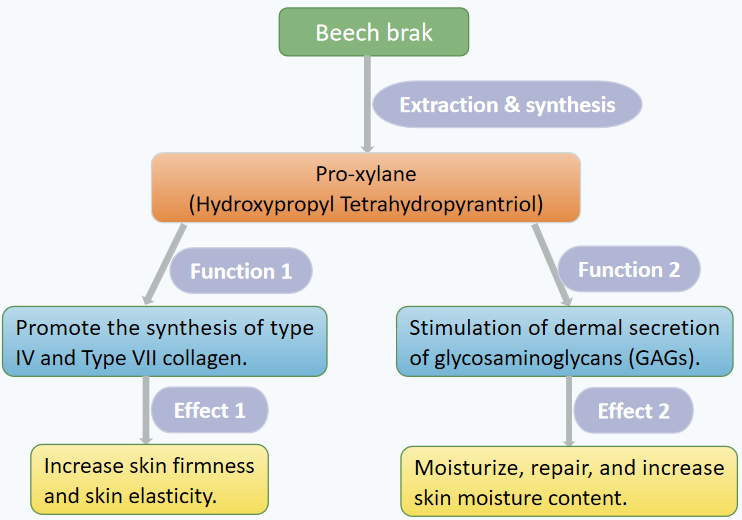Pro-xylane is a patented ingredient independently researched and developed by L’Oréal Group. It is obtained by the condensation of xylose and acetylacetone, followed by a reduction reaction. Xylose is a five-carbon sugar; in aqueous solution, rotation reaction and differential isomerization reaction will occur under certain conditions. L’Oréal’s patented pro-xylane is derived from xylose extracted from beech and obtained by a two-step catalytic reduction reaction in water. It is biodegradable, ecologically friendly, non-accumulative in living organisms and non-ecotoxic. Pro-xylane anti-aging uses in cosmetics are increasingly popular recently.
- Pro-xylane Anti-aging Uses to Promote the Synthesis of Collagen
The part between the epidermis and the dermis is called the dermal epidermal junction (DEJ), and is where collagen IV and collagen VII are located. While young skin has a sinuous dermal epidermal junction, mature and aged skin tends to thin and flatten, causing visible wrinkles in the epidermis.

Pro-xylane up-regulates the deposition of key proteins of the dermal junction, such as collagen IV (a major component of the dense plate), laminin-5, and collagen VII (a major component of the anchoring fibres). In addition, it can increase type I procollagen and protofibrillar protein-1; both of them are important for maintaining skin firmness and elasticity.
More information about pro-xylane, please visit Pro-Xylane Introduction
- Pro-xylane Anti-aging Uses to Promote & Repair GAGs Synthesis
Glycosaminoglycans (GAGs) are long-chain, linear, negatively charged polysaccharides. It consists of repeating disaccharide units containing glycosaminoglycans. It is ubiquitous within the skin, e.g., intracellularly, on the cell surface, and in the extracellular matrix. GAGs mainly includes the major types of chondroitin sulfate, dermatan sulfate, heparan sulfate, heparin, and hyaluronic acid. The total amount of sulfate-containing GAGs is reduced in skin aging caused by the action of intrinsic physiological factors.
GAGs have strong absorptive and adhesive properties, which help to maintain the spatial structure of the extracellular matrix in the dermis, and make the skin full and firm. The GAGs-PGs complex formed by combining GAGs and proteoglycans (PGs) plays an important role in a variety of life activities, affecting cell migration, proliferation, differentiation, and biological functions of a variety of cytokines and proteins. It is therefore of great significance for skin repair and regeneration.
As a xyloside derivatives, pro-xylane can provide binding sites for soluble GAGs, initiate the production of GAGs and repair GAGs without relying on endogenous core proteins, thus achieving the repair of extracellular matrix function. The extracellular matrix (ECM) exists in the dermis of the skin. It consists of a complex meshwork of extracellular proteins, polysaccharides, collagen, and other macromolecules. It can provide support and fixation, nutritional repair, and regulation of intercellular communication and signaling for the cells.

- Pro-xylane Other Uses for Anti-aging
Pro-xylane is a type of ether, a non-ionic surfactant with a remarkable dispersing and emulsifying ability. It helps other active ingredients to enter the skin like ethanol, and thus be absorbed by the skin. At the same time, it has the effect of moisturizing, enhancing skin elasticity and improving skin lines. Also, pro-xylane promotes the regeneration of aged tissues, and rejuvenates the skin.
- Pro-xylane Characteristicsfor Skincare
- Small molecular weight, very strong penetration, good hydration effect.
- The efficacy is on par with retinoland peptide, but pro-xylaneis more gentle than the others to the skin. Suitable for sensitive skin.
- 3. Can be used for anti-aging and skin repair, is a more gentle and comprehensive anti-aging ingredients.
In conclusion, there are two main functions of pro-xylane anti-aging uses for skincare. As a xylose derivative with anti-ageing actives, firstly, pro-xylane can promote the synthesis of collagen types IV and VII at the junction of the epidermis and dermis, enhancing the cohesion between the epidermis and dermis for a firmer skin structure. Secondly, it has the ability to promote the skin’s production of aminoglucosides, or glycosaminoglycans (GAGs), which are able to absorb moisture and make the cellular matrix meshwork more resilient, thus serving to improve cellular firmness, enhance the elasticity of the skin, and prevent ageing.

Figure. pro-xylane anti-aging uses for skincare
Related Reading







